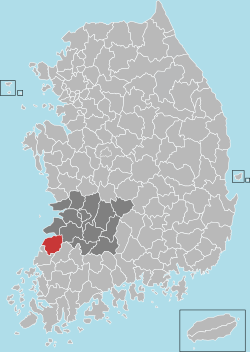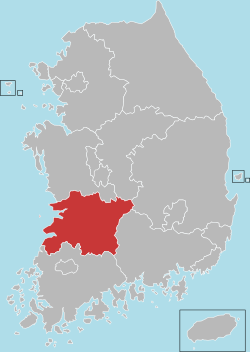Gochang County
| Gochang 고창군 | ||
|---|---|---|
| County | ||
| Korean transcription(s) | ||
| • Hangul | 고창군 | |
| • Hanja | 高敞郡 | |
| • Revised Romanization | Gochang-gun | |
| • McCune-Reischauer | Koch'ang-gun | |
| ||
 Location in South Korea | ||
| Country |
| |
| Region | Honam | |
| Administrative divisions | 1 eup, 13 myeon | |
| Area | ||
| • Total | 606.90 km2 (234.33 sq mi) | |
| Population (2013) | ||
| • Total | 60,522 | |
| • Density | 100/km2 (260/sq mi) | |
| • Dialect | Jeolla | |
Gochang County (Gochang-gun) is a county in North Jeolla Province, South Korea. It is a rural area, and is home to only one institution of higher education: Gochang Polytechnic College.
Famous people from Gochang include the 20th-century poet Midang.
The temple of Seonunsa is also located in Gochang.
The Gochang Dolmens located in Maesan village are listed as a UNESCO World Heritage site and Historic Site #391.
History
Gochang is the town with most dolmen sites in Korea. Some of the dolmens in Dosan-ri, Sanggap-ri and Maesan-ri are of the southern style, whereas most of those in the rest of North Jeolla-do Province are of the northern style. This proves that a wide scope of culture existed in the town in the prehistoric times.
Gochang is where Morobiri, one of the 54 small countries during the ancient Mahan Period was located. The town was called Moryangburi-hyeon or Moryang-hyeon in the Baekje Period, then renamed as Gochanghyun in the United Kingdom of Shilla.
When it comes to the town's famous spots the first things that come to mind are Seonunsa or Seonun Temple and the Gochangeupseong Fortress. Seonunsa Temple is one of the leading Buddhist temples in North Jeolla-do Province. It is not only famous for camellias but also has quite a few Buddhist treasures such as Daeungjeon or the main building and the statue of a Buddhist saint named Jijang.
Meanwhile Gochangeupseong Fortress is the best-preserved fortress in the country. Built in the early days of the Joseon Dynasty to protect the town against Japanese invaders, the fortress has carried on the tradition of stepping on the ground of the fortress. A town named Mujang in Seongnae-ri, Mujang-myeon, also has a fortress. The south gate and mud rampart of the Mujang Town Fortress are in their original form.
Part of Shin Jae Hyo's house remains near a pavilion called Gongbungnu within the Gochang Fortress. Gochang has relics of Dongjae all over a town called Ogari Dangsan, Sadong, Gosu-myeon, which used to be a home for the production of ceramics from celadon porcelains of the Goryeo Dynasty to white porcelains of the Chosun Dynasty and throughout the Japanese colonial period. Sudong-ri, Buan-myeon has a bunchung production site. This is a specific type of porcelain. This place has been designated as a historic site as well. Bongan-ri, Buan-myeon has Kim Seong Su's house. The design is typical houste of wealthy families in the region.
Festival
Gochang Moyang Fortress Festival
Gochang-eup Fortress (Moyang Fortress) was built to prevent invasion from other countries in the first year of King Danjong’s reign during the Joseon Dynasty(1453) with the cooperation of the people of 21 towns (hyeon) in then Jeolla-do and Jeju-do. This is the natural stone fortress whose prototype has been preserved the best condition in Korea.
Among many legends and customs related with the construction of Moyang Fortress, the most famous one is Dapseong folklore game. People walk along the 1,684m-long fortress with a palm-sized stone on head. It was based on our ancestor’s wisdom that walking around the fortress makes the ground stronger and can be used in emergency situations. It has been said that you can heal your leg illness for one round of walking around the fortress, live healthy and long for two rounds and go to the heaven for three rounds. Every year many people participate in the folklore game.
Green Barley Field Festival
The Green Barley Field Festival is held at Hagwon Farm in Gongeum-myeon, Gochang-gun from mid-April to mid-May every year.
The vast and beautiful barley field has become widely known among photographers and travelers. The increasing number of tourists to the place requires the administration to be involved to keep order, address inconveniences and introduce the local culture. Such necessity made the local people and the Gochang-gun Office go into negotiation to host the festival since 2004.
It is the first barley-themed scenic agricultural festival on a low hill. The beautiful landscape created by the barley field attracts hundreds of thousands of visitors every year.
Visitors can have various experiences including walking in the barley field, making traditional food with barley, making barley flute and folk play such as walking on a rope, tuho and Korean jumping.
Visitors can taste barley-based boiled rice, rice cake, traditional snack and pepper paste and enjoy various cultural performances and traditional performances. During the festival, exhibitions including international scenic agricultural photo exhibition and international academic conventions on tourism and agriculture are held. And along with barley, special products of Gochang such as mountain berry are traded in the festival.
Twin towns – Sister cities
Gochang is twinned with:
-
 Gwanak-gu, South Korea
Gwanak-gu, South Korea -
 Seongbuk-gu, South Korea
Seongbuk-gu, South Korea -
 Dongnae-gu, South Korea
Dongnae-gu, South Korea -
 Sangju, South Korea
Sangju, South Korea -
 Zaozhuang, China
Zaozhuang, China
See also
External links
Coordinates: 35°26′00″N 126°42′00″E / 35.4333333433°N 126.70000001°E
